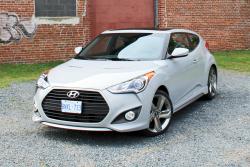 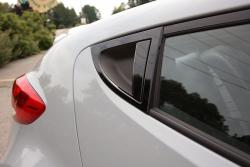 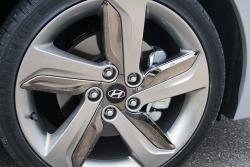 2014 Hyundai Veloster Turbo. Click image to enlarge |
Review and photos by Mark Atkinson
Who ever thought Hyundai could be hip? The three-door Veloster proved it captured attention by beating out some serious competition during AJAC Test Fest a few years ago and was voted the Best Sports/Performance Car Under $50,000 by the group in the process. It certainly was a contentious victory since while the car was nimble and fun enough, it didn’t really like being pushed around much. However, the major complaint revolved around the car’s lack of performance relative to its looks – with only 138 horsepower from a 1.6-litre four-cylinder engine, there was a distinct lack of get-up-and-go.
Hyundai obviously had a fix in mind. The solution comes in the form of a turbocharger attached to the same engine, along with an intercooler, stronger internals and other tweaks. If the words Veloster Turbo has you picturing Rhys Millen in full, sideways, four-wheels-smoking drifts in his 500-plus-horsepower Global RallyCross car, then sorry to disappoint. Horsepower is boosted to 201 and torque to 195 lb-ft. Both are serious improvements over the regular Veloster, and on paper push the car closer into territory occupied by legends like the Honda Civic Si, Volkswagen GTI and Mini Cooper S.
In reality, the Hyundai doesn’t feel anywhere near as manic as the competitors it’s pitching the Veloster Turbo against. The flat torque curve, common in these modern forced-induction engines, masks some of the thrill, missing that big rush towards redline from other pocket rockets. Against the watch, there’s no doubt the Turbo is faster, but the butt-dyno says otherwise. One possibility is that the Turbo had been filled with regular gasoline by someone else… it works just fine that way, but extra performance can be expected for those who invest the couple dollars a tank in high-octane premium.
Another theory would be that the gearing in the six-speed manual transmission is still tuned more for fuel economy than sporting drives. That assumption is held up by the Veloster Turbo’s 9.8 L/100 km in the city and 7.1 L/100 km ratings from the EPA, which aren’t far off the 8.4 city/6.5 highway from the less-powerful original.
The Turbo model’s suspension tuning is pretty much identical to the plain Veloster, which means entertaining but not giggle-inducing. The spring rate is too firm and shock damping just isn’t quite right, allowing too many thumps and bangs into the cabin without offering the controlled body motions you’d expect. It’s hard to be too picky about that given how far the company’s styling, technology and reliability have risen in recent years, but other new-or-revised products – Kia Soul, Hyundai Genesis – are really impressive. There’s proof the knowledge is there, it just has to filter down to the rest of them. If the Veloster had the same sorted balance as a GTI or the chuckability of a Fiesta ST, I’d stop bitching.
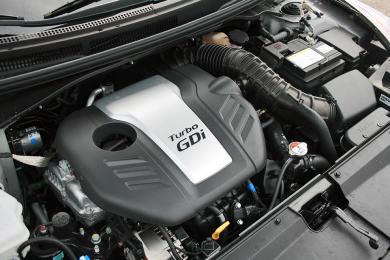 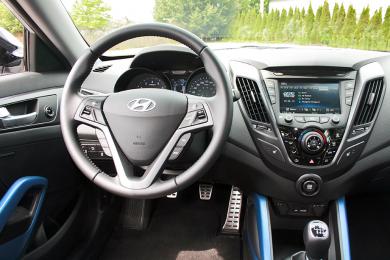 2014 Hyundai Veloster Turbo engine bay & dashboard. Click image to enlarge |
The Turbo does sport a quicker-ratio steering rack, but feedback is largely absent. That trait comes directly from every Hyundai and most other manufacturers making moves to fuel-saving electric power steering units rather than traditional pump-driven ones.
The larger front brakes are one thing upgraded from the base car and prove to work just fine, and the six-speed shifter is reasonably precise. It doesn’t have the sweet mechanical action of a Honda or Mini, but Hyundai gets credit for still offering one… There wasn’t an opportunity to try the optional six-speed automatic, which unlike the regular Veloster, is a ‘real’ torque-converter auto, not an automated dual-clutch transmission whose reaction times could be timed using a sundial.
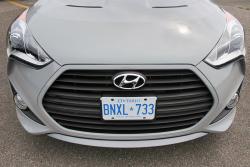 2014 Hyundai Veloster Turbo. Click image to enlarge |
Well, while the Veloster Turbo might be more sheep in wolf’s clothing, at least the fur it’s wrapped in is funky. The Turbo model gets a more aggressive front end with a gigantic blacked-out grille, and different driving lights. The headlights with the LED detailing are carried over too, while LEDs are incorporated into the rear tails. The side skirts are lower, and the different five-spoke 18-inch wheels are finished in matte grey and chrome accents. The centre-routed exhaust remains, although here the pipes look like rocket launchers, sized like they were sourced from a heavy-duty turbo-diesel pickup.
My test car was finished in a light flat grey that was totally in keeping with the design, but there are options for racier blues, reds and a nuclear orange. Hyundai does offer a matte-finish paint in a much darker grey, much like BMW did with some M3s a while back. But rather than costing four or five grand, here the option is only $1,000.









